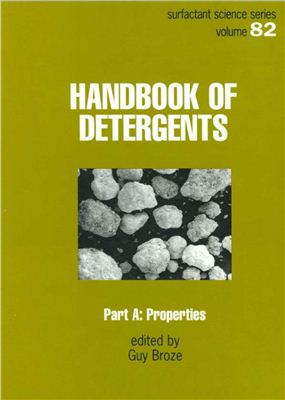CRC Press. 1999. 814p (Part A), 1342p(Part B), 593p(Part F)
Part A of this handbook describes the raw materials and potential interactions of detergent products before, during and after use, focusing on the development and mechanisms of action of cleaning components. The text presents the basic physiochemical concepts necessary to formulate new, safer and more effective detergent products.
The second installment of the multivolume Handbook of Detergents deals with the potential environmental impact of detergents as a result of their production, formulation, usage, consumption, and disposal. This volume forms a comprehensive treatise on the multidimensional issues involved and emphasizes the alignment of scientific knowledge with the relevant contemporary data and methodologies in toxicology, ecotoxicology, and environmental risk assessment. With contributions from over 50 experts worldwide, this volume discusses industry procedures involving surfactant and detergent treatments and explores global conces centering on recent legislative and regulatory developments.
This sixth part of the multi-volume Handbook of Detergents focuses on the production of surfactants, builders and other key components of detergent formulations, including the various multi-dimensional aspects and implications on detergent formulations and applications domestically, institutionally, in industry and agriculture, with all the environmental consequences involved. Thus, Part F constitutes a comprehensive treatise of the multi-dimensional issues relating to this industry production technology, emphasizing the alignment of scientific knowledge and up-to-date technological and technical know-how with the relevant contemporary applied practice.
An inteational effort and industry-academia collaboration, this volume features expert contributions, focusing on the contemporary state-of-the-art conceing the many facets of the production of detergents and surfactants.
Thus, the Handbook of Detergents, Part F – Production, deals with the production of anionic, cationic, nonionic, and amphoteric surfactants, key builders, bleaching and whitening agents, enzymes and other components of detergent formulations in different contexts, gauges and related conces, and discusses various technological procedures of production processes involving the components of surfactants and detergents.
Part A of this handbook describes the raw materials and potential interactions of detergent products before, during and after use, focusing on the development and mechanisms of action of cleaning components. The text presents the basic physiochemical concepts necessary to formulate new, safer and more effective detergent products.
The second installment of the multivolume Handbook of Detergents deals with the potential environmental impact of detergents as a result of their production, formulation, usage, consumption, and disposal. This volume forms a comprehensive treatise on the multidimensional issues involved and emphasizes the alignment of scientific knowledge with the relevant contemporary data and methodologies in toxicology, ecotoxicology, and environmental risk assessment. With contributions from over 50 experts worldwide, this volume discusses industry procedures involving surfactant and detergent treatments and explores global conces centering on recent legislative and regulatory developments.
This sixth part of the multi-volume Handbook of Detergents focuses on the production of surfactants, builders and other key components of detergent formulations, including the various multi-dimensional aspects and implications on detergent formulations and applications domestically, institutionally, in industry and agriculture, with all the environmental consequences involved. Thus, Part F constitutes a comprehensive treatise of the multi-dimensional issues relating to this industry production technology, emphasizing the alignment of scientific knowledge and up-to-date technological and technical know-how with the relevant contemporary applied practice.
An inteational effort and industry-academia collaboration, this volume features expert contributions, focusing on the contemporary state-of-the-art conceing the many facets of the production of detergents and surfactants.
Thus, the Handbook of Detergents, Part F – Production, deals with the production of anionic, cationic, nonionic, and amphoteric surfactants, key builders, bleaching and whitening agents, enzymes and other components of detergent formulations in different contexts, gauges and related conces, and discusses various technological procedures of production processes involving the components of surfactants and detergents.

